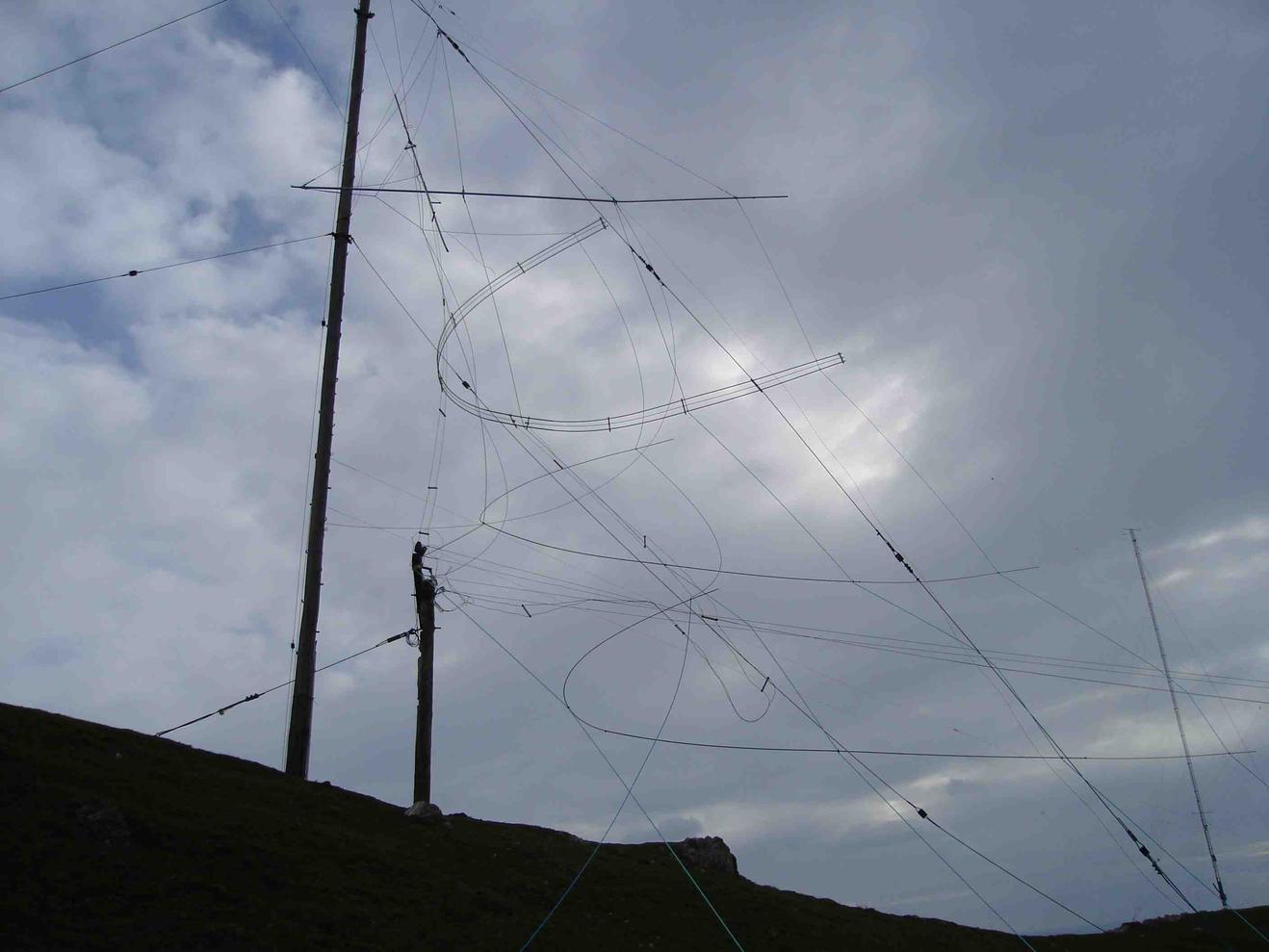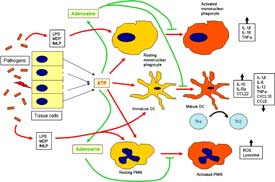In this three part series we look at the Light’s exciting work at the University of Utah on ME/CFS. First – we look at the Light’s attempt to validate their gene expression findings, then we examine what they believe may be ground zero for ME/CFS, and finally we tie together their findings with a theory paper by Shapiro suggesting that different kind of herpesvirus may be a work in ME/CFS. Thanks to the Lights and Judith Shapiro for their willingness to answer questions and, as always, to Dennis for his invaluable help getting research papers.
- Part I – Bad Reception? The Light Gene Expression Studies
- Part II – The Dorsal Ganglia – Ground Zero for ME?
- Part III – Varicella Zoster Virus, Shingles and ME/CFS – A New Herpesvirus for ME
- Part IV – Pts. I/II/III Combined – the Quickie Version
Bad Reception? The Light Gene Expression Studies and ME/CFS
 One Question to Rule Them All – The biggest question in ME/CFS pathophysiology is what’s causing the mysterious and perhaps unique post-exertional relapse (PER) that can knock patients out of work, and confine some of them to their houses and to their beds. The PER question is ground zero for ME/CFS; crack that issue and you have legitimized the disorder and pointed an arrow straight at it’s heart. Outside of XMRV no work over the past couple years has been more exciting or more filled with the potential to answer that question than the Light’s gene expression work.
One Question to Rule Them All – The biggest question in ME/CFS pathophysiology is what’s causing the mysterious and perhaps unique post-exertional relapse (PER) that can knock patients out of work, and confine some of them to their houses and to their beds. The PER question is ground zero for ME/CFS; crack that issue and you have legitimized the disorder and pointed an arrow straight at it’s heart. Outside of XMRV no work over the past couple years has been more exciting or more filled with the potential to answer that question than the Light’s gene expression work.
They’re not the first to do gene expression work, of course; a slew of ME/CFS gene expression studies have been performed with variable results but their study is different. Instead of looking at thousands of genes they’ve targeted a few genes they know play a large role in producing chronic pain and fatigue states.
 The genes they’re targeting produce ‘receptors’, the radar components our cells use to monitor what’s going on in the body. Our muscle health, for instance, is monitored for signs of damage (lactate acid, ATP and pH levels) by cells using receptors called the Receptor Ion Channel Complex (RICC). If those receptors receive information suggesting muscles are being damaged (in the form of increased ATP, lactate and pH levels), they send a message to the brain which responds by sending out pain and fatigue signals to get us to slow down … not unlike, in some ways, the immune system produces flu-like symptoms (aka sickness behavior) to isolate us and get us to slow down during a cold. It’s the brain’s response to damage in the body that largely determines how much fatigue and pain we are in.
The genes they’re targeting produce ‘receptors’, the radar components our cells use to monitor what’s going on in the body. Our muscle health, for instance, is monitored for signs of damage (lactate acid, ATP and pH levels) by cells using receptors called the Receptor Ion Channel Complex (RICC). If those receptors receive information suggesting muscles are being damaged (in the form of increased ATP, lactate and pH levels), they send a message to the brain which responds by sending out pain and fatigue signals to get us to slow down … not unlike, in some ways, the immune system produces flu-like symptoms (aka sickness behavior) to isolate us and get us to slow down during a cold. It’s the brain’s response to damage in the body that largely determines how much fatigue and pain we are in.
Pain and Fatigue Biomarkers in ME/CFS – Drs. Light and Dr. Bateman looked for levels of three types of receptors that tend to light up when laboratory animals are in a chronic fatigue/pain state. These receptors were from the sensory system (pain/pleasure/touch), the sympathetic nervous system (fight or flight response) and the immune system: three systems that work together to produce chronic pain and fatigue.
The specific receptors were:
- sensory receptors (ASICS, 2PX4, 2PX5, TPRIV1)
- adrenergic receptors (sympathetic nervous system) (Alpha 2a, Beta-1, Beta-2, COMT)
- cytokine receptors (IL-6, IL-10, TNF-a, CD14, TLRFA)
Their first study found that moderate exercise ballooned the levels of these receptors for two days in people with ME/CFS but that levels dropped more rapidly in healthy controls. This was the study that produced all the ‘oohs’ and ‘aahs’ at the Reno IACFS/ME conference a year and a half ago. Now they’ve completed the vitally important second, or ‘validation’, study. If they can validate their original findings, their research should move forward … and ME/CFS researchers may have finally have found some of the biomarkers they’ve been looking for for so long. If they can’t validate it, one of the most promising research leads in years fades away. Given the Lights’ ability to demonstrate that the pain and fatigue produced by exercise was real – this was one study we very much wanted to succeed.
Because fatigue can be very severe in multiple sclerosis also, they included groups of MS, CFS, CFS/FM, and FM (without CFS) patients in the study.
Results
Completely Different Kinds of Fatigue/Pain? One of the most striking findings was how different the types of fatigue/pain were in the different patient groups. This suggests, of course, that however similar the fatigue and pain may look in, say, CFS, FM, MS, depression and healthy controls, something very different is going on beneath the surface.
Before Exercise – Nothing – After Exercise – Big Changes – At rest, all the participants – people with CFS, FM, multiple sclerosis and healthy controls – looked about the same. After exercise they couldn’t have been more different.
- Exercise Tolerant Group: the Healthy Controls – Remarkably, at least from the point of someone with ME/CFS, the fatigue and pain receptor levels actually dropped in the healthy controls at the 30 minute post-exercise mark; that is, exercise actually REDUCED their fatigue and pain levels.
- Exercise Intolerant Group: the ME/CFS Patients – The receptor levels ballooned, on the other hand, in the people with ME/CFS at 30 minutes, then ramped up even higher at the 24 hour mark and took just a slight dip at 48 hours – indicating that the Lights actually cut off the study far too early. That 30 minutes of moderate exercise somehow had parts of the sensory, sympathetic and immune systems of the people with ME/CFS still in something of a state of shock even 2 days later was remarkable and as you can see in the slide, visually stunning.
- A Head Turner: the Fibromyalgia group – This group was COMPLETELY different, which must have been something of a head turner. In fact, most receptor levels decreased after exercise, suggesting that for people with FM only, as with the healthy controls, exercise tends to reduce pain and fatigue levels. This suggested that FM, for all its surface similarities to CFS, is at least in part, a very different disorder – as Dr. Natelson’s findings have suggested.
The CFS subsets
One of the most exciting things about this study was the uncovering of two major subsets in CFS. The bigger group (Big ME/CFS Group) displayed high levels of receptors across the board, suggesting that exercise had thrown all three systems – the sensory, sympathetic nervous system and immune system – into disarray. Only one system was disturbed in the smaller group (Little ME/CFS Group), on the other hand. Let’s take that one first.
Tilting Strangely – The Little ME/CFS Group
Almost 1/3 of the CFS and CFS/FM group displayed a unique pattern of dysregulation. The really intriguing thing about this subset is that it’s so much simpler than the usual CFS case. Instead of multiple systems being affected, only one was. Dr. Light said
Not only is it a simpler reaction, but instead of their receptor levels rising, they shot off in the opposite direction – suggesting that a key system simply didn’t engage. These patients had decreased (this is not a typo: not increased, but decreased) sympathetic nervous system receptor activation . . . and nothing else. Their sensory receptors were fine, their muscle receptors were not going bonkers over signs of increased muscle damage, their immune system receptors were entirely unperturbed by the exercise … but the activity of their adrenergic, i.e. their sympathetic nervous system, receptors plummeted suggesting that exercise had done something very strange to this major system of the body. The SNS governs the stress response and determines heart rate, blood flows to the tissues and blood volume, and helps to regulate the immune system.
 This group was different in another way: seventy-one percent of this group had trouble standing (POTS (postural tachycardia syndrome – rapid heartbeat upon standing)), compared with only 18% of the CFS group, suggesting that the study may have peeled away a nice big subset of the ME/CFS population. Thankfully, this finding made perfect sense.
This group was different in another way: seventy-one percent of this group had trouble standing (POTS (postural tachycardia syndrome – rapid heartbeat upon standing)), compared with only 18% of the CFS group, suggesting that the study may have peeled away a nice big subset of the ME/CFS population. Thankfully, this finding made perfect sense.
The receptor which decreased after exercise (AD2A) is essentially in charge of diverting blood from muscles that don’t need it (non-contracting muscles) to muscles that do need (contracting muscles). This kind of diversion of blood is necessary because even in healthy people (let alone low blood volume CFS patients) there’s never enough blood to do all the bodies tasks at once. As soon as you eat, for instance, blood rushes to your stomach and away from the brain. If you then immediately exercise then blood goes from your stomach to your muscles – slowing digestion. The body is always moving blood from areas that need to it areas that don’t.
When we stand a process called the ‘muscle pump’ contracts the muscles in the legs in order to keep blood from pooling in them. But what if the Lights are right and a key receptor doesn’t get the message to tighten up those leg muscles? Then blood drains out of head and upper extremities and pools in the legs setting off a ferocious (and futile) attempt by the heart in the form of increased heart rate (POTS) to get it back into the head.
This finding, if it is validated, demonstrates the power of this kind of work. Except for the POTS, these patients seemed exactly like the other patients: they had trouble exercising, they met the standard criteria for CFS … and yet the Lights’ work suggests that their illness may becompletely different from the rest of the group. Being able to peel away 30% of the CFS population into their own subset using (by the way) pretty simple tests, would be an extraordinary breakthrough because, if this group exists, it has been mucking up the study results of the other group or groups for over 30 years (and vice versa).
Treatment – If you’re in this group you may have struck paydirt (at least eventually), because your problems may be pretty clear. Dr. Light said that, if they are correct, “that group could have a targeted treatment just for their sympathetic nervous system.”
Right now POTS patients have at least three options – each of which boosts the functioning of the sympathetic nervous system.
- Midrodrine, which is used to treat low blood pressure, activates some of the receptors that may not be working well in ME/CFS.
- Propranolol is a non-selective beta blocker used to treat high blood pressure, migraines, PTSD and post-exertional headache (interestingly enough) among other things. Less appears to be more with Propanolol as low doses were more effective at reducing pain and POTS symptoms than high doses. (Click here for more on propanolol and ME/CFS)
- Clonidine is used to treat high blood pressure, neuropathic pain, insomnia, migraine and ADHD.
These drugs aren’t miracle treatments and they are not specifically focused on the abnormalities the Lights have found, but they can help. Propranolol, perhaps the best of the bunch, for instance, can get CFS patients upright and can reduce problems with post-exertional relapse – which could improve fitness and pain markedly, but the fatigue is still there.
Even if a drug isn’t optimally targeted, though, Dr. Light speculated, it could still be good enough: if a close-enough drug could give enough of a boost, then an individually tailored exercise program could, combined with that drug, eventually remove the fatigue as well. She said, “asking the drug to do everything by itself is too much” but a drug might be able to get the system back on its feet enough, so to speak, that it could relearn how to work properly – i.e., to find ‘normal’ again.
The Big ME/CFS Group
The bigger group of ME/CFS patients (about 70% of the patients), on the other hand, is a mess. They had a bit of everything going on … the abnormal activation of a pain receptor (P2X4 – read: increased pain), increased levels of sympathetic nervous system receptors (a-2a, B2 – read: altered blood flows, low blood volume, immune regulation ?) and an immune receptor (IL-10) were all turned up – suggesting that these people had the kind of complex multisystemic disorder researchers have been speculating about for over a decade.
A focus emerges – There is a lot going on, but the Lights are looking hard at one particular group of receptors called the ‘purinergic receptors”. The specific purinergic receptor upregulated in ME/CFS, P2X1, has been associated with prolonged pain states, arthritis, nerve pain and inflammation. Dr. Light said this receptor “does two bad things at once … it’s a really serious player …” and it appears to be upregulated in about 70% of people with ME/CFS.
 Just think about the implications of this: several studies have shown that exercise in people with ME/CFS makes them more sensitive to pain. Here the Lights have shown that an activated receptor is present in CFS that could both increase their sensitivity to pain and prolong whatever inflammation is present. A receptor that could account for both the pain and inflammation present in CFS after exercise would be a gold mine.
Just think about the implications of this: several studies have shown that exercise in people with ME/CFS makes them more sensitive to pain. Here the Lights have shown that an activated receptor is present in CFS that could both increase their sensitivity to pain and prolong whatever inflammation is present. A receptor that could account for both the pain and inflammation present in CFS after exercise would be a gold mine.
It turns out that there are seven different purinergic 2x receptors and they’ve narrowed down the problematic one to just #4. Right now, unfortunately, the only purinergic receptor blockers available block all the P2 receptors which, she said, “because they’re everywhere in the body, will just make people sicker.”
Treatment – They are so high on this receptor, however, that they’re actively thinking about how to develop a drug to deal with it. She said, “we have to get a drug company interested in developing a specific antagonist for these receptors;” and they have approached one company, but haven’t been able to stir up enough interest yet. They are working on a long-delayed CFS study with Pfizer which could change things, though. (See below).
An important study underway
 The Pfizer Study – A successful Pfizer study could propel their theory and their unique approach to fatigue and pain into the big leagues. After a year and a half weight the Lights and Dr. Bateman are finaly starting a trial funded by Pfizer that will attempt to use the gene expression markers they’ve found in CFS to validate Lyrica’s (pregbalin’s) effectiveness in ME/CFS patients in severe pain.
The Pfizer Study – A successful Pfizer study could propel their theory and their unique approach to fatigue and pain into the big leagues. After a year and a half weight the Lights and Dr. Bateman are finaly starting a trial funded by Pfizer that will attempt to use the gene expression markers they’ve found in CFS to validate Lyrica’s (pregbalin’s) effectiveness in ME/CFS patients in severe pain.
This is a big study for the Lights. If, as some patients get better on Lyrica their gene expression levels drop, they’ll be able to make a strong case that they have found biomarkers for the pain and fatigue in ME/CFS. Having a new technology be validated in CFS, of all disorders, of course, would be an astounding thing.
A successful study would also be a tremendous boost for Pfizer, on the other hand, because it would behoove them to be able to target patients that do well on their drug. Right now about 20% of patients who try Lyrica get worse, and 20% just don’t respond and together, that 40% gives Lyrica a bad reputation which makes patients and doctors reluctant to use the drug. Being able to identify in advance the patients who will do well would improve Lyrica’s reputation and make doctors more likely to prescribe it. Insurance companies would benefit because they wouldn’t be wasting a lot of money as doctors stumble around trying a drug that doesn’t work for anyone.
A successful Pfizer study would drag the pharmaceutical industry in but there’s much more on the Lights plate. They’re recently completed a gene expression study in severely fatigued MS patients which found a different gene signature. They’re also in the midst of a study of severely fatigued prostate cancer survivors and are finding the same thing….Dr. Light expected to find that the fatigue state in different illnesses would show up similarly but its not…..The Lights are also engaged in examining gene expression levels using varying amounts of exercise with healthy controls. They’re finding that even pushing them severely does not begin to produce the kind of fatigue and pain gene upregulation found in CFS (instead those gene levels go down.).
Collaboration, Collaboration, Collaboration – Dr. Light is exchanging samples and testing materials with both Dr. Klimas and Dr. Cook. Dr. Klimas will look for increased cytokines in Dr. Light’s patients and Dr. Light will do her gene expression tests on leukocytes (white blood cells) from Dr. Klimas’s exercise study. If they are both successful, they’ll have validation of their findings on two levels. Funding is always an issue in CFS, but duplicating their results in patients from both Miami and Wisconsin would give the Lights a big leg up when they go to the NIH and say they want to expand this study or do a treatment trial in ME/CFS.
The Key Ingredient – Stress Testing – This puts this study in an increasingly long list of studies which indicate that ‘stressors’ are needed to fully demonstrate the depth of the abnormalities that are present in ME/CFS. Cumulatively, these studies should, over time, compel the recognition that post-exertional malaise or relapse is a hallmark symptom in ME/CFS, thus eventually dispensing with the overly broad and misleading term ‘fatigue’ as the major descriptor in CFS.
The fact that the study would have been a complete wash if they hadn’t decided to have the participants engage in moderate exercise, of course, brings up the question how many other failed studies failed simply because they relied only on measurements taken at rest. As more and more researchers push their subjects with exercise and other stressors, we should see more and more positive ME/CFS studies.
Surprisingly, to my knowledge no one has tried to look at pathogen activity after exercise. Epstein-Barr Virus (EBV) has been show to be reactivated by physical or psychological stressors – and would seem to be a good candidate as would other herpesviruses.
Bang for Your Buck – The Light work demonstrates the important role patient support plays in ME/CFS research. Preliminary funding from the CFIDS Association (which continues to support them) allowed the Lights to gather the data needed to get the bigger grants (and now a study funded by Pfizer). Nobody knows how the Light’s work will turn out but the success of their Broderick, Hubers and Shungu’s work with the CAA and the WPI’s work with XMRVit seems likely that beginning of the answer for ME will very likely come from relatively small amounts of seed money provided by an ME/CFS organization to fund innovative work.
Conclusions
The Lights brought a lot of good news to the NIH State of the Knowledge Workshop. They validated their earlier study which validated, in rather stunning fashion, the post-exertional abnormalities they had found earlier in CFS. They demonstrated that all fatigue is not the same; that each kind of severely fatiguing disorder (FM/CFS/Multiple Sclerosis) has its own unique gene expression signature and that the biggie – the disorder with fatigue in its name (ME/CFS) – may have several subsets. They feel they may even have found ground zero for CFS in the dorsal root ganglia and the microglia.
After a year and a half, they finally got a Pfizer study funded which could lay the groundwork for more widespread acceptance of their unique approach to ME/CFS. They feel they may have targeted a specific receptor that plays a major role in the ‘Big CFS Group’. Lastly they are working with two other important CFS researchers to expand the reach of their work. It’s been a very good couple of years for the Lights’ work on ME/CFS but we’re not finished with them yet – they also believe they may have identified ground zero for ME/CFS. Check that out in the next part of the series – The Dorsal Ganglia – Ground Zero for ME?
Light on ME/CFS Series
- Part II – The Dorsal Ganglia – Ground Zero for ME?
- Part III – Varicella Zoster Virus, Shingles and ME/CFS – A New Herpesvirus for ME
- Part IV – Pts. I/II/III Combined – the Quickie Version
